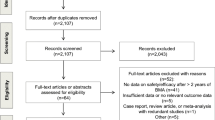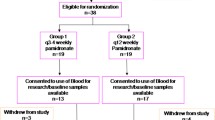Summary
In 1989, a prospective randomized multicenter study was initiated in order to determine the safety and efficacy of oral clodronate in myeloma patients. The primary objective of this long-term trial is to evaluate whether supportive clodronate is able to prevent or retard the progression of bone disease and reduce the occurrence of characteristic complications: pain, pathologic fractures, and hypercalcemia. We now report first results as an interim analysis, including data obtained from 26 patients (total number of Tübingen patientsn=36) who entered the study at theMedizinische Universitätsklinik Tübingen. Patients were randomized to receive either chemotherapy alone (melphalan 15 mg/m2 i.v. on day 1 and prednisolone 60 mg/m2 orally on days 1–4 every 4 weeks (control group) or in combination with 1600 mg clodronate/day orally as a single dose for a period of at least 1 year. Repeated radiologic examinations in addition to hematologic and biochemical analysis were performed in order to evaluate the skeletal status with respect to lytic bone lesions and osteoporosis and the course of serum M protein and light chain excretion into urine. Clodronate treatment resulted in a significant decrease of serum calcium concentrations and of biochemical indices for bone resorption. No clodronate-related toxicity or hypocalcemia was oberved. In patients treated with chemotherapy alone, this effect was less marked and discontinuous. Clodronate-treated patients developed fewer progressive bone lesions (significant for lytic, not for osteoporotic lesions). No hypercalcemic episodes occurred in the clodronate-treated patients, but there were six episodes in the control group. Whereas the number of vertebral fractures was evidently less is clodronate-treated patients, three of those patients suffered from multiple fractures of long bones and ribs. All together, 12 pathologic fractures occurred in five clodronate-treated patients, whereas in the control group 23 pathologic fractures occurred in the same number of patients during the whole observation period. The final analysis of all multicenter included patients should clarify these findings. There was a significant finding that clodronate proved to have an analgesic effect.
Similar content being viewed by others
References
Bartl R, Frisch B, Fateh-Moghadam A, Kettner G, Jaeger K, Sommerfeld W (1987) Histologic classification and staging of multiple myeloma: a retrospective and prospective study of 674 cases. Am J Clin Pathol 87: 342–355
Bataille R, Chappard D, Alexandre C, Dessauw P, Sany J (1986) Importance of quantitative histology of bone changes in monoclonal gammopathy. Br J Cancer 53: 805–810
Bataille R, Chappard D, Marcelli C, Dessauw P, Sany J, Baldet P, Alexandre C (1989) Mechanisms of bone destruction in multiple myeloma: the importance of an unbalanced process in determining the severity of lytic bone disease. J Clin Oncol 7: 1909–1914
Cherng NC, Asal NR, Kuebler JP, Lee ET, Solanski D (1991) Prognostic factors in multiple myeloma. Cancer 67: 3150–3156
Delmas PD, Charhon S, Chapuy MC, Vignon E, Briancon D, Edourd C, Meunier PJ (1982) Long-term effects of dichloromethylene diphosphonate (Cl2MDP) on sekeletal lesions in multiple myeloma. Metab Bone Dis Res 4: 163–168
Kanis JA, McCloskey EV (1990) The use of clodronate in disorders of calcium and skeletal metabolism. In: Kanis JA (ed) Calcium metabolism. Progress in basic clinical pharmacology. Karger, Basel, pp 89–136
Merlini G, Parrinello GA, Piccinini L, Crema F, Fiorentini ML, Riccardi A, Pavesi F, Novazzi F, Silingardi V, Ascari E (1990) Long-term effects of parenteral dichloromethylene bisphosphonate (Cl2MDP) on bone disease of myeloma patients treated with chemotherapy. Hematol Oncol 8: 23–30
Miller AB, Hoogstraten B, Staquet M, Winkler A (1981) Reporting results of cancer treatment. Cancer 47: 207–214
Paterson AD, Kanis JA, Cameron EC, Douglas DL, Beard DJ, Preston FE, Russel RGG (1983) The use of dichloromethylene diphosphonate for the management of hypercalcaemia in multiple myeloma. Br J Haematol 54: 121–132
Payne RB, Little AJ, Williams RB, Milner JR (1973) Interpretation of serum calcium in patients with abnormal serum protein. Br Med J 4: 643–646
Siris ES, Sherman WH, Baquiran DC, Schlatterer JP, Osserman EF, Chanfield RE (1980) Effects of dichloromethylene diphosphonate on skeletal mobilization of calcium in multiple myeloma. N Engl J Med 302: 310–315
Author information
Authors and Affiliations
Rights and permissions
About this article
Cite this article
Clemens, M.R., Fessele, K. & Heim, M.E. Multiple myeloma: effect of daily dichloromethylene bisphosphonate on skeletal complications. Ann Hematol 66, 141–146 (1993). https://doi.org/10.1007/BF01697625
Received:
Accepted:
Issue Date:
DOI: https://doi.org/10.1007/BF01697625




